Report: Statistical Analysis of Employee Job Insecurity and Well-being
VerifiedAdded on 2023/01/19
|13
|2793
|68
Report
AI Summary
This report presents a statistical research study conducted on the associations between quantitative and qualitative job insecurity and employee well-being in the Belgian banking sector. The study involved a survey of 15,000 employees from a total population of 69,000 across 63 banks. The report explores the rationale behind the sample size, the use of random sampling, and the reliability and validity of the research findings. It examines the advantages and disadvantages of the sampling method and discusses the importance of social demographics in understanding the research participants. Furthermore, the report outlines the survey method as the research design, detailing the steps involved in conducting a survey and analyzing the data. The study investigates the impact of job insecurity on job satisfaction and psychological distress, providing valuable insights into employee perceptions and organizational practices.
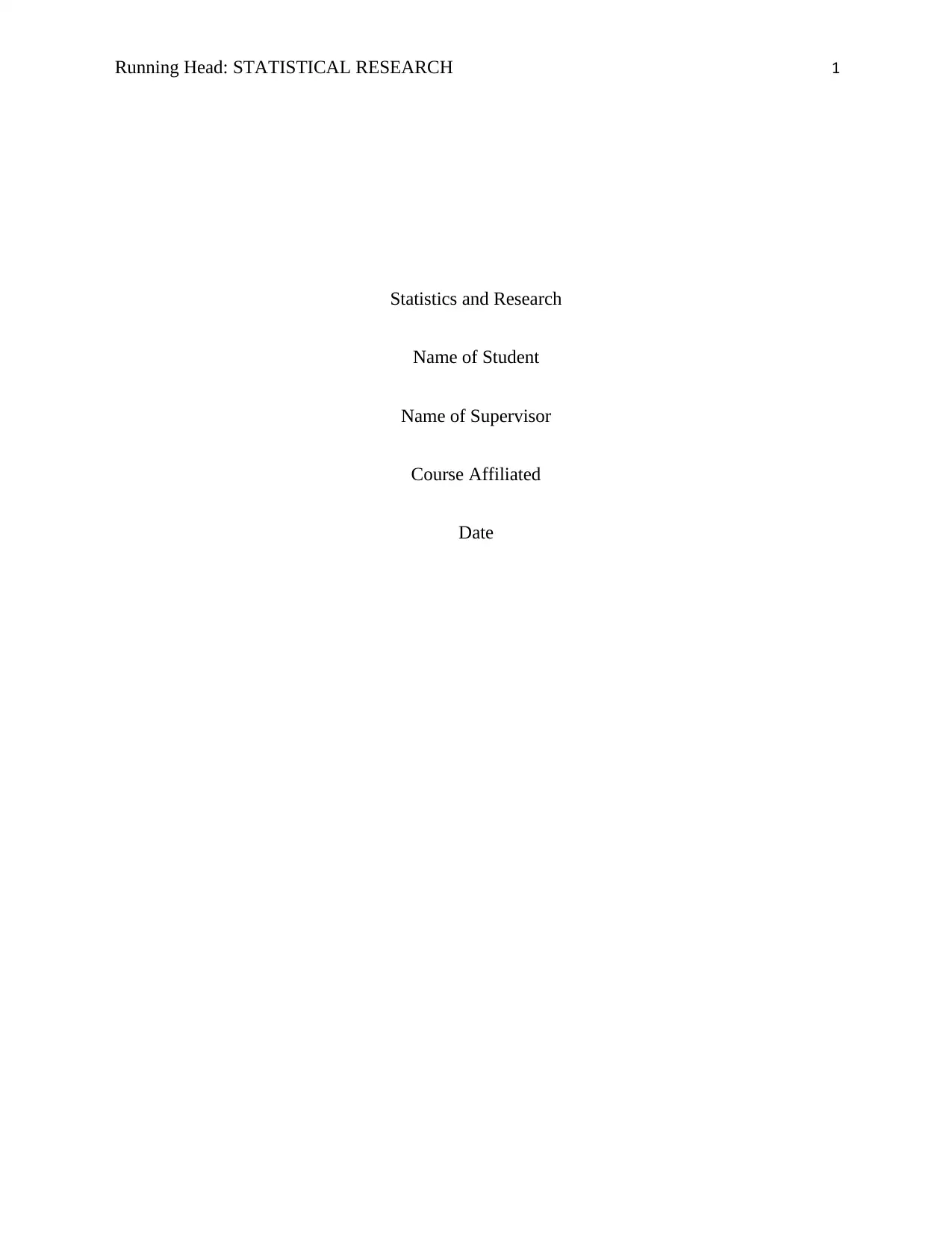
Running Head: STATISTICAL RESEARCH 1
Statistics and Research
Name of Student
Name of Supervisor
Course Affiliated
Date
Statistics and Research
Name of Student
Name of Supervisor
Course Affiliated
Date
Paraphrase This Document
Need a fresh take? Get an instant paraphrase of this document with our AI Paraphraser
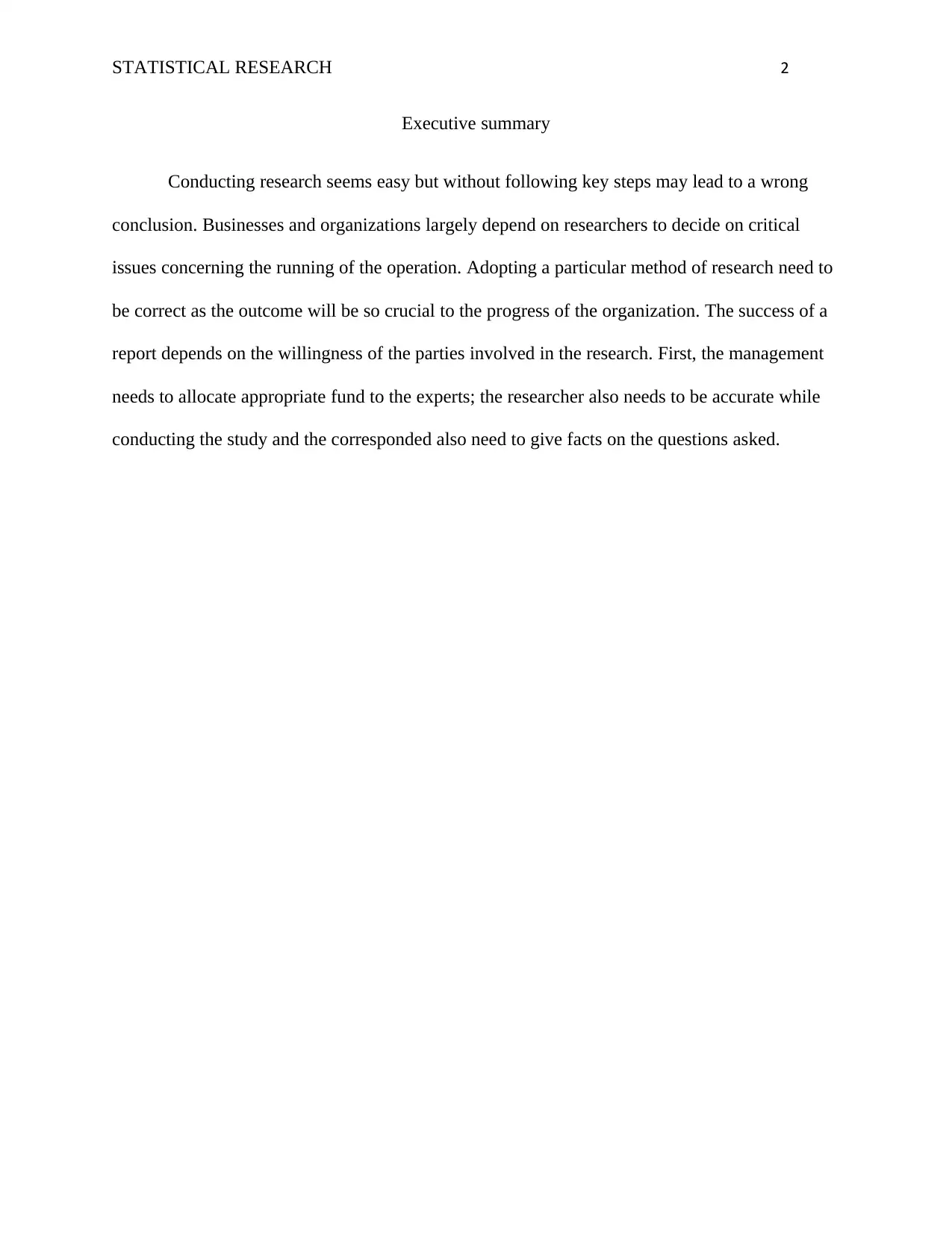
STATISTICAL RESEARCH 2
Executive summary
Conducting research seems easy but without following key steps may lead to a wrong
conclusion. Businesses and organizations largely depend on researchers to decide on critical
issues concerning the running of the operation. Adopting a particular method of research need to
be correct as the outcome will be so crucial to the progress of the organization. The success of a
report depends on the willingness of the parties involved in the research. First, the management
needs to allocate appropriate fund to the experts; the researcher also needs to be accurate while
conducting the study and the corresponded also need to give facts on the questions asked.
Executive summary
Conducting research seems easy but without following key steps may lead to a wrong
conclusion. Businesses and organizations largely depend on researchers to decide on critical
issues concerning the running of the operation. Adopting a particular method of research need to
be correct as the outcome will be so crucial to the progress of the organization. The success of a
report depends on the willingness of the parties involved in the research. First, the management
needs to allocate appropriate fund to the experts; the researcher also needs to be accurate while
conducting the study and the corresponded also need to give facts on the questions asked.
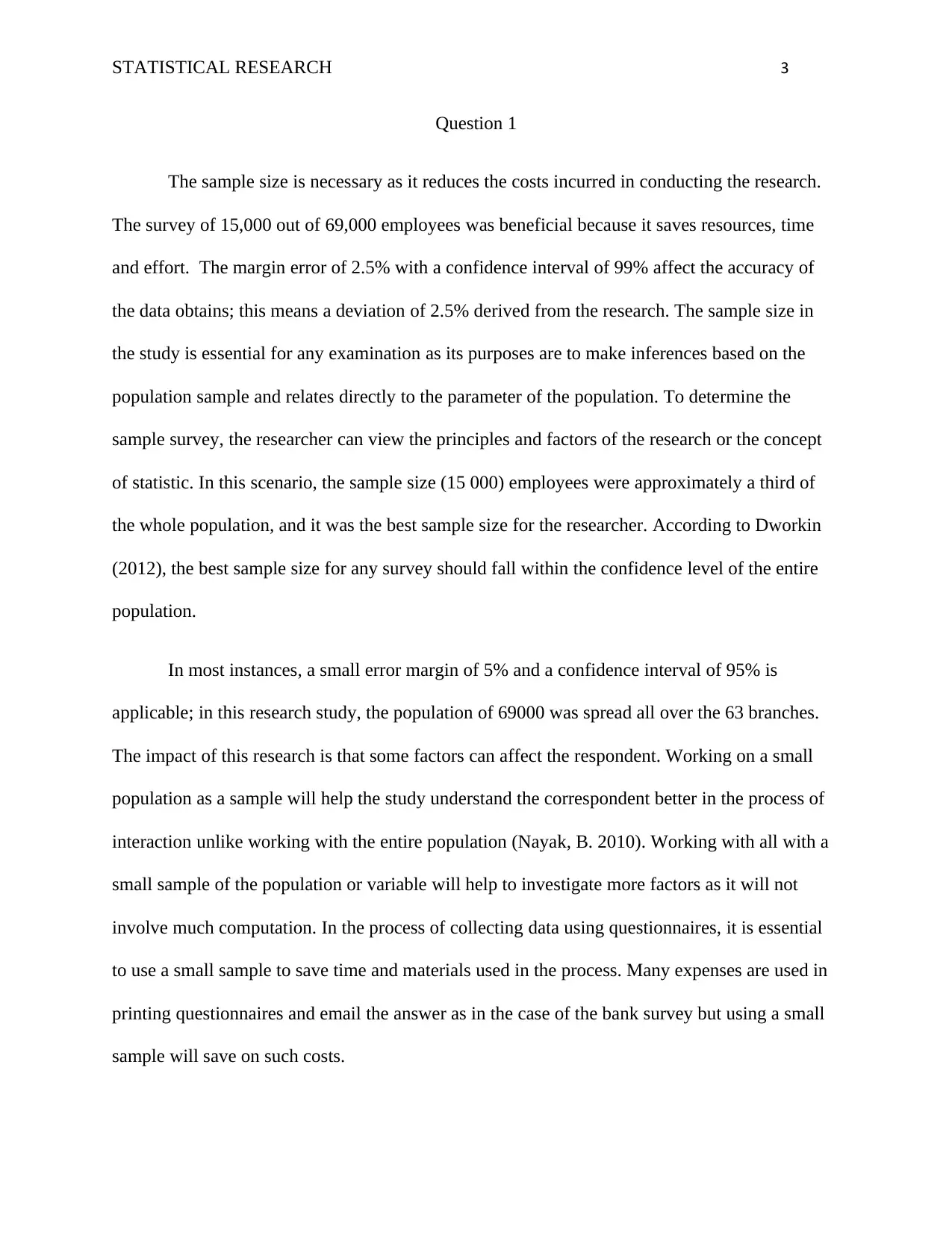
STATISTICAL RESEARCH 3
Question 1
The sample size is necessary as it reduces the costs incurred in conducting the research.
The survey of 15,000 out of 69,000 employees was beneficial because it saves resources, time
and effort. The margin error of 2.5% with a confidence interval of 99% affect the accuracy of
the data obtains; this means a deviation of 2.5% derived from the research. The sample size in
the study is essential for any examination as its purposes are to make inferences based on the
population sample and relates directly to the parameter of the population. To determine the
sample survey, the researcher can view the principles and factors of the research or the concept
of statistic. In this scenario, the sample size (15 000) employees were approximately a third of
the whole population, and it was the best sample size for the researcher. According to Dworkin
(2012), the best sample size for any survey should fall within the confidence level of the entire
population.
In most instances, a small error margin of 5% and a confidence interval of 95% is
applicable; in this research study, the population of 69000 was spread all over the 63 branches.
The impact of this research is that some factors can affect the respondent. Working on a small
population as a sample will help the study understand the correspondent better in the process of
interaction unlike working with the entire population (Nayak, B. 2010). Working with all with a
small sample of the population or variable will help to investigate more factors as it will not
involve much computation. In the process of collecting data using questionnaires, it is essential
to use a small sample to save time and materials used in the process. Many expenses are used in
printing questionnaires and email the answer as in the case of the bank survey but using a small
sample will save on such costs.
Question 1
The sample size is necessary as it reduces the costs incurred in conducting the research.
The survey of 15,000 out of 69,000 employees was beneficial because it saves resources, time
and effort. The margin error of 2.5% with a confidence interval of 99% affect the accuracy of
the data obtains; this means a deviation of 2.5% derived from the research. The sample size in
the study is essential for any examination as its purposes are to make inferences based on the
population sample and relates directly to the parameter of the population. To determine the
sample survey, the researcher can view the principles and factors of the research or the concept
of statistic. In this scenario, the sample size (15 000) employees were approximately a third of
the whole population, and it was the best sample size for the researcher. According to Dworkin
(2012), the best sample size for any survey should fall within the confidence level of the entire
population.
In most instances, a small error margin of 5% and a confidence interval of 95% is
applicable; in this research study, the population of 69000 was spread all over the 63 branches.
The impact of this research is that some factors can affect the respondent. Working on a small
population as a sample will help the study understand the correspondent better in the process of
interaction unlike working with the entire population (Nayak, B. 2010). Working with all with a
small sample of the population or variable will help to investigate more factors as it will not
involve much computation. In the process of collecting data using questionnaires, it is essential
to use a small sample to save time and materials used in the process. Many expenses are used in
printing questionnaires and email the answer as in the case of the bank survey but using a small
sample will save on such costs.
⊘ This is a preview!⊘
Do you want full access?
Subscribe today to unlock all pages.

Trusted by 1+ million students worldwide
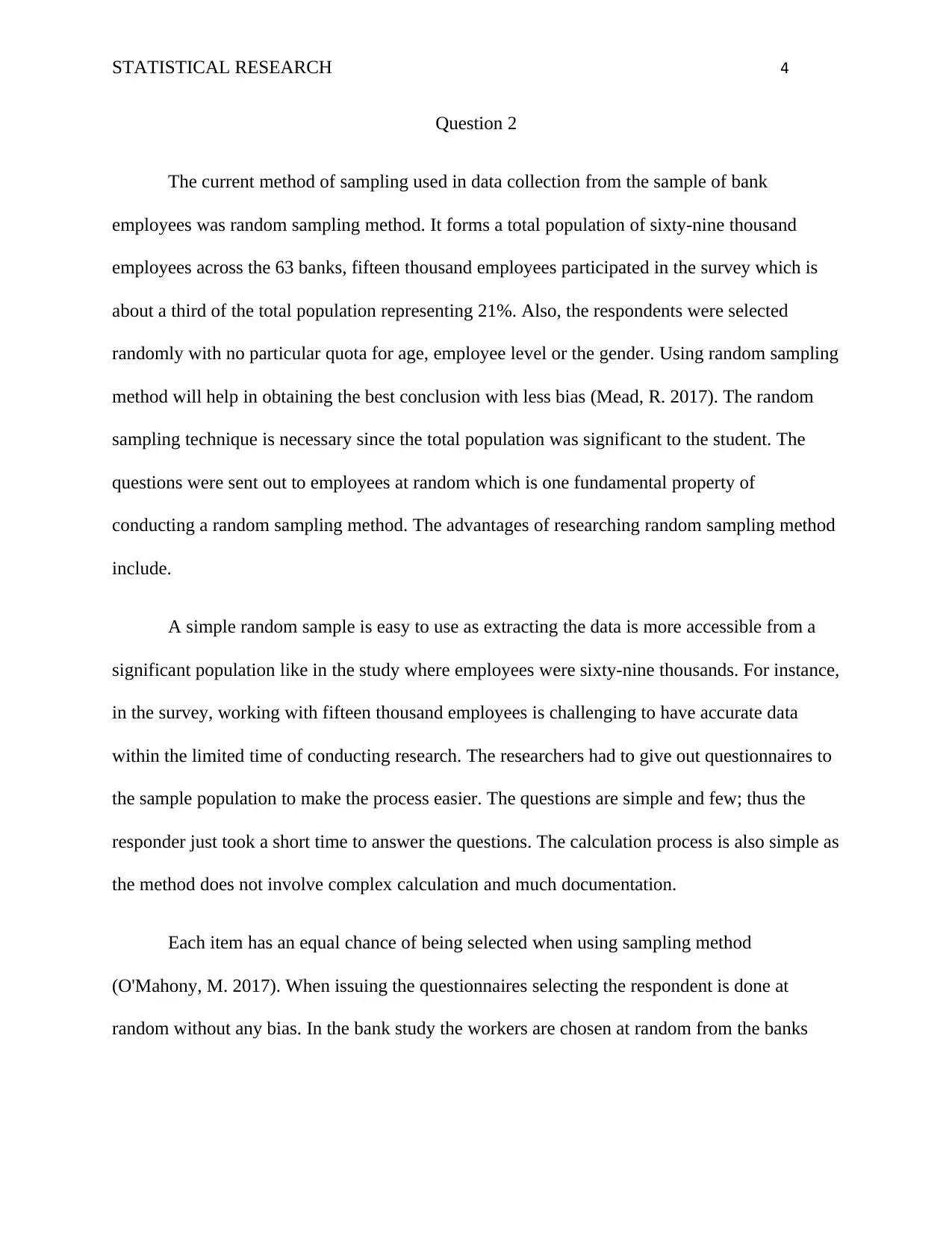
STATISTICAL RESEARCH 4
Question 2
The current method of sampling used in data collection from the sample of bank
employees was random sampling method. It forms a total population of sixty-nine thousand
employees across the 63 banks, fifteen thousand employees participated in the survey which is
about a third of the total population representing 21%. Also, the respondents were selected
randomly with no particular quota for age, employee level or the gender. Using random sampling
method will help in obtaining the best conclusion with less bias (Mead, R. 2017). The random
sampling technique is necessary since the total population was significant to the student. The
questions were sent out to employees at random which is one fundamental property of
conducting a random sampling method. The advantages of researching random sampling method
include.
A simple random sample is easy to use as extracting the data is more accessible from a
significant population like in the study where employees were sixty-nine thousands. For instance,
in the survey, working with fifteen thousand employees is challenging to have accurate data
within the limited time of conducting research. The researchers had to give out questionnaires to
the sample population to make the process easier. The questions are simple and few; thus the
responder just took a short time to answer the questions. The calculation process is also simple as
the method does not involve complex calculation and much documentation.
Each item has an equal chance of being selected when using sampling method
(O'Mahony, M. 2017). When issuing the questionnaires selecting the respondent is done at
random without any bias. In the bank study the workers are chosen at random from the banks
Question 2
The current method of sampling used in data collection from the sample of bank
employees was random sampling method. It forms a total population of sixty-nine thousand
employees across the 63 banks, fifteen thousand employees participated in the survey which is
about a third of the total population representing 21%. Also, the respondents were selected
randomly with no particular quota for age, employee level or the gender. Using random sampling
method will help in obtaining the best conclusion with less bias (Mead, R. 2017). The random
sampling technique is necessary since the total population was significant to the student. The
questions were sent out to employees at random which is one fundamental property of
conducting a random sampling method. The advantages of researching random sampling method
include.
A simple random sample is easy to use as extracting the data is more accessible from a
significant population like in the study where employees were sixty-nine thousands. For instance,
in the survey, working with fifteen thousand employees is challenging to have accurate data
within the limited time of conducting research. The researchers had to give out questionnaires to
the sample population to make the process easier. The questions are simple and few; thus the
responder just took a short time to answer the questions. The calculation process is also simple as
the method does not involve complex calculation and much documentation.
Each item has an equal chance of being selected when using sampling method
(O'Mahony, M. 2017). When issuing the questionnaires selecting the respondent is done at
random without any bias. In the bank study the workers are chosen at random from the banks
Paraphrase This Document
Need a fresh take? Get an instant paraphrase of this document with our AI Paraphraser
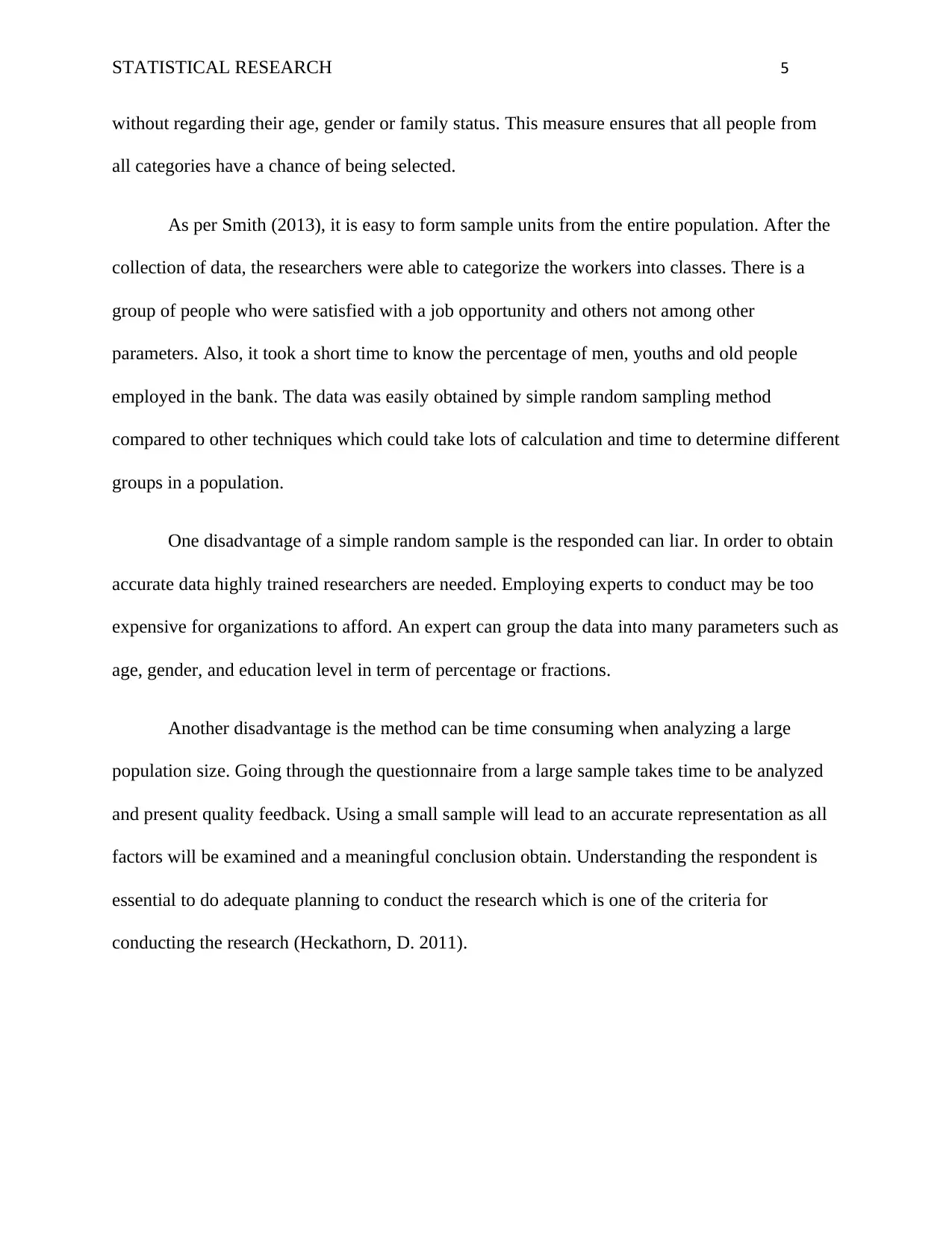
STATISTICAL RESEARCH 5
without regarding their age, gender or family status. This measure ensures that all people from
all categories have a chance of being selected.
As per Smith (2013), it is easy to form sample units from the entire population. After the
collection of data, the researchers were able to categorize the workers into classes. There is a
group of people who were satisfied with a job opportunity and others not among other
parameters. Also, it took a short time to know the percentage of men, youths and old people
employed in the bank. The data was easily obtained by simple random sampling method
compared to other techniques which could take lots of calculation and time to determine different
groups in a population.
One disadvantage of a simple random sample is the responded can liar. In order to obtain
accurate data highly trained researchers are needed. Employing experts to conduct may be too
expensive for organizations to afford. An expert can group the data into many parameters such as
age, gender, and education level in term of percentage or fractions.
Another disadvantage is the method can be time consuming when analyzing a large
population size. Going through the questionnaire from a large sample takes time to be analyzed
and present quality feedback. Using a small sample will lead to an accurate representation as all
factors will be examined and a meaningful conclusion obtain. Understanding the respondent is
essential to do adequate planning to conduct the research which is one of the criteria for
conducting the research (Heckathorn, D. 2011).
without regarding their age, gender or family status. This measure ensures that all people from
all categories have a chance of being selected.
As per Smith (2013), it is easy to form sample units from the entire population. After the
collection of data, the researchers were able to categorize the workers into classes. There is a
group of people who were satisfied with a job opportunity and others not among other
parameters. Also, it took a short time to know the percentage of men, youths and old people
employed in the bank. The data was easily obtained by simple random sampling method
compared to other techniques which could take lots of calculation and time to determine different
groups in a population.
One disadvantage of a simple random sample is the responded can liar. In order to obtain
accurate data highly trained researchers are needed. Employing experts to conduct may be too
expensive for organizations to afford. An expert can group the data into many parameters such as
age, gender, and education level in term of percentage or fractions.
Another disadvantage is the method can be time consuming when analyzing a large
population size. Going through the questionnaire from a large sample takes time to be analyzed
and present quality feedback. Using a small sample will lead to an accurate representation as all
factors will be examined and a meaningful conclusion obtain. Understanding the respondent is
essential to do adequate planning to conduct the research which is one of the criteria for
conducting the research (Heckathorn, D. 2011).
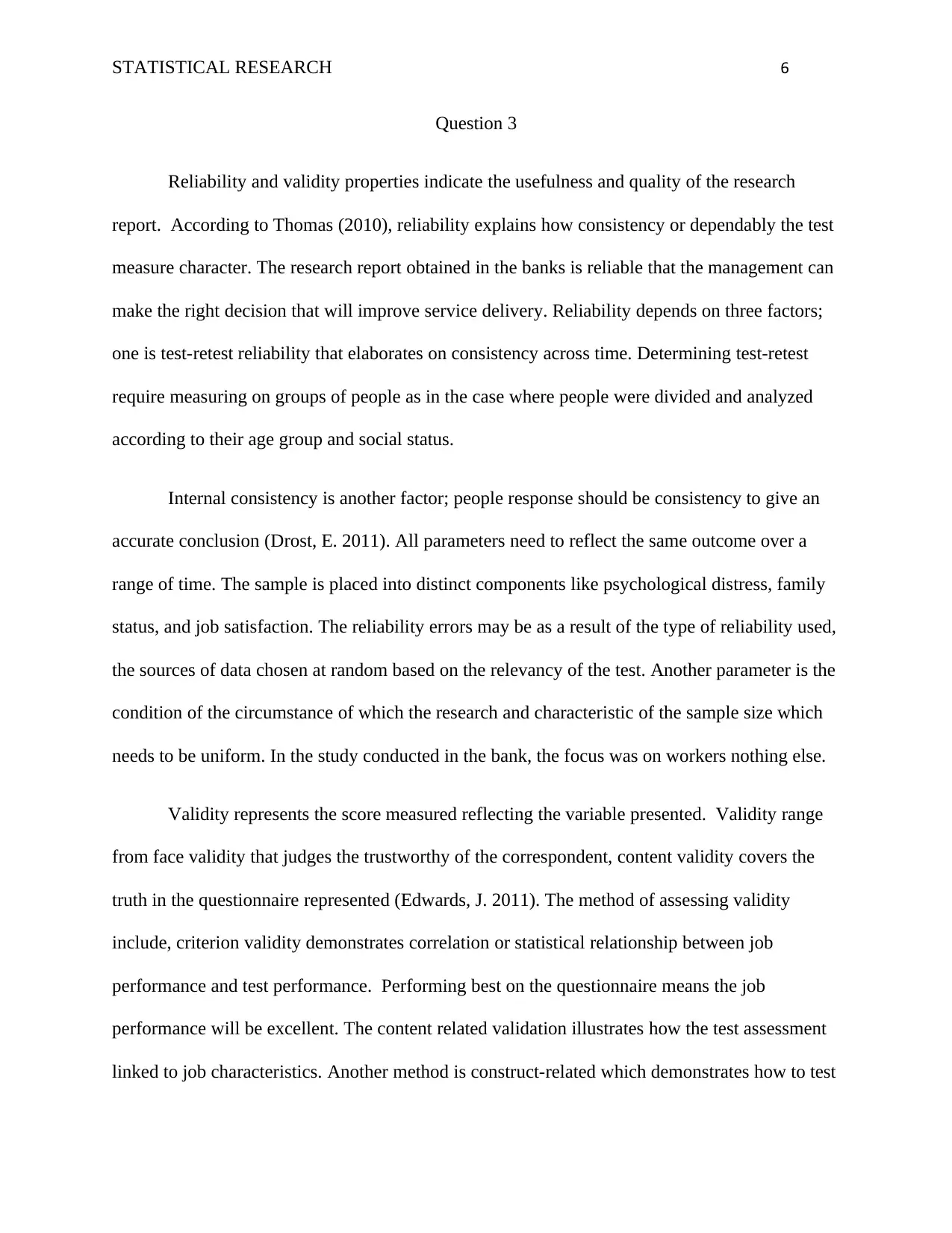
STATISTICAL RESEARCH 6
Question 3
Reliability and validity properties indicate the usefulness and quality of the research
report. According to Thomas (2010), reliability explains how consistency or dependably the test
measure character. The research report obtained in the banks is reliable that the management can
make the right decision that will improve service delivery. Reliability depends on three factors;
one is test-retest reliability that elaborates on consistency across time. Determining test-retest
require measuring on groups of people as in the case where people were divided and analyzed
according to their age group and social status.
Internal consistency is another factor; people response should be consistency to give an
accurate conclusion (Drost, E. 2011). All parameters need to reflect the same outcome over a
range of time. The sample is placed into distinct components like psychological distress, family
status, and job satisfaction. The reliability errors may be as a result of the type of reliability used,
the sources of data chosen at random based on the relevancy of the test. Another parameter is the
condition of the circumstance of which the research and characteristic of the sample size which
needs to be uniform. In the study conducted in the bank, the focus was on workers nothing else.
Validity represents the score measured reflecting the variable presented. Validity range
from face validity that judges the trustworthy of the correspondent, content validity covers the
truth in the questionnaire represented (Edwards, J. 2011). The method of assessing validity
include, criterion validity demonstrates correlation or statistical relationship between job
performance and test performance. Performing best on the questionnaire means the job
performance will be excellent. The content related validation illustrates how the test assessment
linked to job characteristics. Another method is construct-related which demonstrates how to test
Question 3
Reliability and validity properties indicate the usefulness and quality of the research
report. According to Thomas (2010), reliability explains how consistency or dependably the test
measure character. The research report obtained in the banks is reliable that the management can
make the right decision that will improve service delivery. Reliability depends on three factors;
one is test-retest reliability that elaborates on consistency across time. Determining test-retest
require measuring on groups of people as in the case where people were divided and analyzed
according to their age group and social status.
Internal consistency is another factor; people response should be consistency to give an
accurate conclusion (Drost, E. 2011). All parameters need to reflect the same outcome over a
range of time. The sample is placed into distinct components like psychological distress, family
status, and job satisfaction. The reliability errors may be as a result of the type of reliability used,
the sources of data chosen at random based on the relevancy of the test. Another parameter is the
condition of the circumstance of which the research and characteristic of the sample size which
needs to be uniform. In the study conducted in the bank, the focus was on workers nothing else.
Validity represents the score measured reflecting the variable presented. Validity range
from face validity that judges the trustworthy of the correspondent, content validity covers the
truth in the questionnaire represented (Edwards, J. 2011). The method of assessing validity
include, criterion validity demonstrates correlation or statistical relationship between job
performance and test performance. Performing best on the questionnaire means the job
performance will be excellent. The content related validation illustrates how the test assessment
linked to job characteristics. Another method is construct-related which demonstrates how to test
⊘ This is a preview!⊘
Do you want full access?
Subscribe today to unlock all pages.

Trusted by 1+ million students worldwide
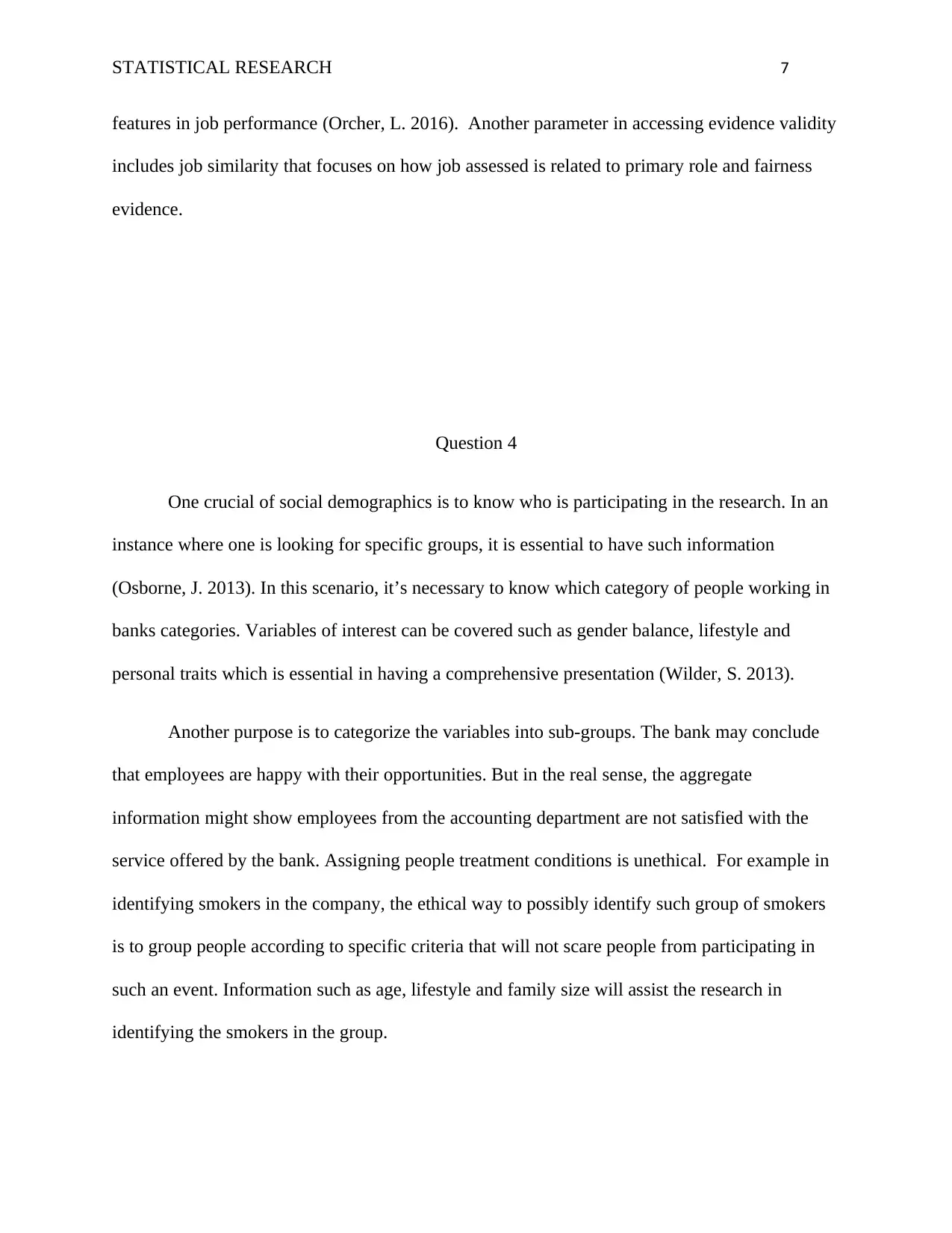
STATISTICAL RESEARCH 7
features in job performance (Orcher, L. 2016). Another parameter in accessing evidence validity
includes job similarity that focuses on how job assessed is related to primary role and fairness
evidence.
Question 4
One crucial of social demographics is to know who is participating in the research. In an
instance where one is looking for specific groups, it is essential to have such information
(Osborne, J. 2013). In this scenario, it’s necessary to know which category of people working in
banks categories. Variables of interest can be covered such as gender balance, lifestyle and
personal traits which is essential in having a comprehensive presentation (Wilder, S. 2013).
Another purpose is to categorize the variables into sub-groups. The bank may conclude
that employees are happy with their opportunities. But in the real sense, the aggregate
information might show employees from the accounting department are not satisfied with the
service offered by the bank. Assigning people treatment conditions is unethical. For example in
identifying smokers in the company, the ethical way to possibly identify such group of smokers
is to group people according to specific criteria that will not scare people from participating in
such an event. Information such as age, lifestyle and family size will assist the research in
identifying the smokers in the group.
features in job performance (Orcher, L. 2016). Another parameter in accessing evidence validity
includes job similarity that focuses on how job assessed is related to primary role and fairness
evidence.
Question 4
One crucial of social demographics is to know who is participating in the research. In an
instance where one is looking for specific groups, it is essential to have such information
(Osborne, J. 2013). In this scenario, it’s necessary to know which category of people working in
banks categories. Variables of interest can be covered such as gender balance, lifestyle and
personal traits which is essential in having a comprehensive presentation (Wilder, S. 2013).
Another purpose is to categorize the variables into sub-groups. The bank may conclude
that employees are happy with their opportunities. But in the real sense, the aggregate
information might show employees from the accounting department are not satisfied with the
service offered by the bank. Assigning people treatment conditions is unethical. For example in
identifying smokers in the company, the ethical way to possibly identify such group of smokers
is to group people according to specific criteria that will not scare people from participating in
such an event. Information such as age, lifestyle and family size will assist the research in
identifying the smokers in the group.
Paraphrase This Document
Need a fresh take? Get an instant paraphrase of this document with our AI Paraphraser
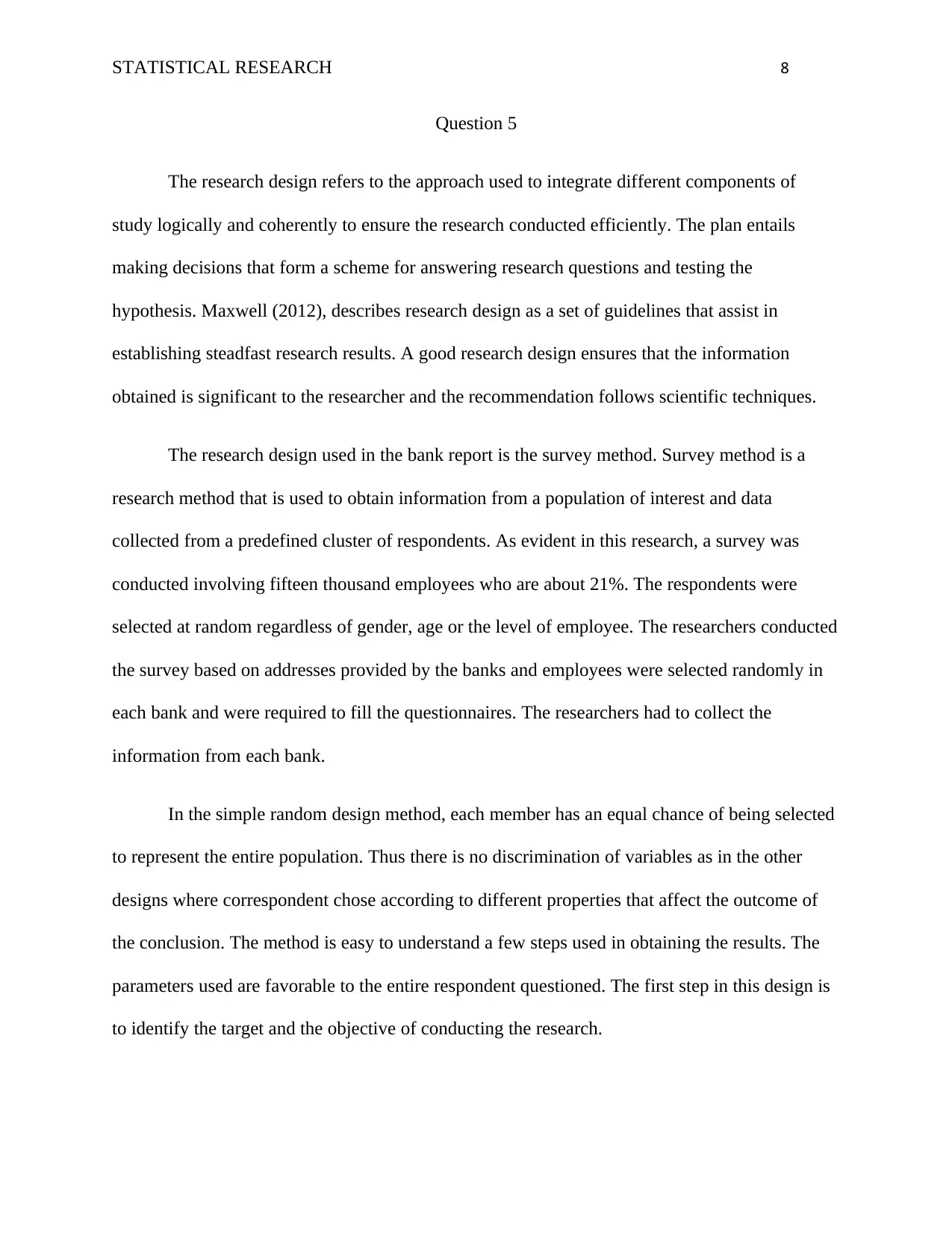
STATISTICAL RESEARCH 8
Question 5
The research design refers to the approach used to integrate different components of
study logically and coherently to ensure the research conducted efficiently. The plan entails
making decisions that form a scheme for answering research questions and testing the
hypothesis. Maxwell (2012), describes research design as a set of guidelines that assist in
establishing steadfast research results. A good research design ensures that the information
obtained is significant to the researcher and the recommendation follows scientific techniques.
The research design used in the bank report is the survey method. Survey method is a
research method that is used to obtain information from a population of interest and data
collected from a predefined cluster of respondents. As evident in this research, a survey was
conducted involving fifteen thousand employees who are about 21%. The respondents were
selected at random regardless of gender, age or the level of employee. The researchers conducted
the survey based on addresses provided by the banks and employees were selected randomly in
each bank and were required to fill the questionnaires. The researchers had to collect the
information from each bank.
In the simple random design method, each member has an equal chance of being selected
to represent the entire population. Thus there is no discrimination of variables as in the other
designs where correspondent chose according to different properties that affect the outcome of
the conclusion. The method is easy to understand a few steps used in obtaining the results. The
parameters used are favorable to the entire respondent questioned. The first step in this design is
to identify the target and the objective of conducting the research.
Question 5
The research design refers to the approach used to integrate different components of
study logically and coherently to ensure the research conducted efficiently. The plan entails
making decisions that form a scheme for answering research questions and testing the
hypothesis. Maxwell (2012), describes research design as a set of guidelines that assist in
establishing steadfast research results. A good research design ensures that the information
obtained is significant to the researcher and the recommendation follows scientific techniques.
The research design used in the bank report is the survey method. Survey method is a
research method that is used to obtain information from a population of interest and data
collected from a predefined cluster of respondents. As evident in this research, a survey was
conducted involving fifteen thousand employees who are about 21%. The respondents were
selected at random regardless of gender, age or the level of employee. The researchers conducted
the survey based on addresses provided by the banks and employees were selected randomly in
each bank and were required to fill the questionnaires. The researchers had to collect the
information from each bank.
In the simple random design method, each member has an equal chance of being selected
to represent the entire population. Thus there is no discrimination of variables as in the other
designs where correspondent chose according to different properties that affect the outcome of
the conclusion. The method is easy to understand a few steps used in obtaining the results. The
parameters used are favorable to the entire respondent questioned. The first step in this design is
to identify the target and the objective of conducting the research.
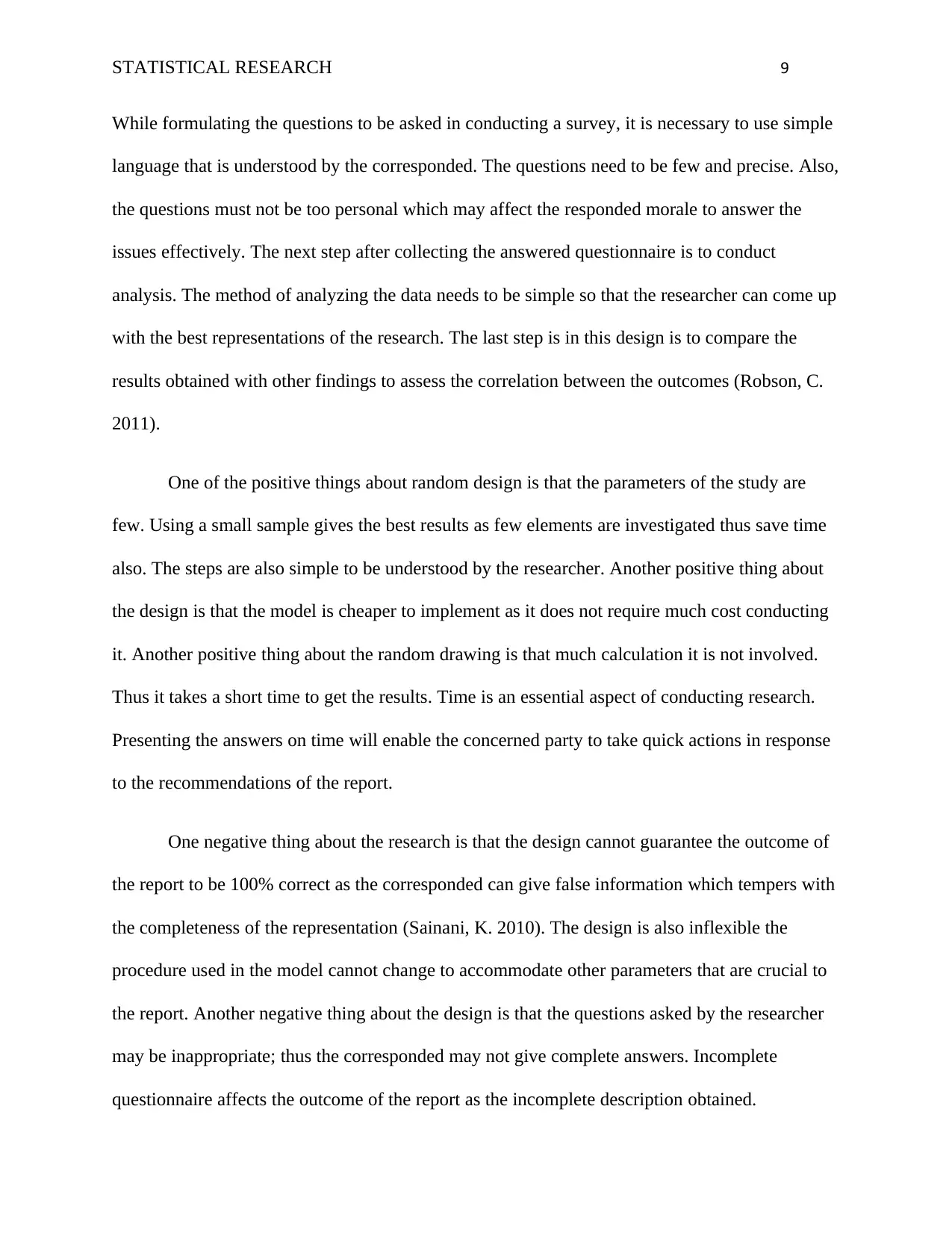
STATISTICAL RESEARCH 9
While formulating the questions to be asked in conducting a survey, it is necessary to use simple
language that is understood by the corresponded. The questions need to be few and precise. Also,
the questions must not be too personal which may affect the responded morale to answer the
issues effectively. The next step after collecting the answered questionnaire is to conduct
analysis. The method of analyzing the data needs to be simple so that the researcher can come up
with the best representations of the research. The last step is in this design is to compare the
results obtained with other findings to assess the correlation between the outcomes (Robson, C.
2011).
One of the positive things about random design is that the parameters of the study are
few. Using a small sample gives the best results as few elements are investigated thus save time
also. The steps are also simple to be understood by the researcher. Another positive thing about
the design is that the model is cheaper to implement as it does not require much cost conducting
it. Another positive thing about the random drawing is that much calculation it is not involved.
Thus it takes a short time to get the results. Time is an essential aspect of conducting research.
Presenting the answers on time will enable the concerned party to take quick actions in response
to the recommendations of the report.
One negative thing about the research is that the design cannot guarantee the outcome of
the report to be 100% correct as the corresponded can give false information which tempers with
the completeness of the representation (Sainani, K. 2010). The design is also inflexible the
procedure used in the model cannot change to accommodate other parameters that are crucial to
the report. Another negative thing about the design is that the questions asked by the researcher
may be inappropriate; thus the corresponded may not give complete answers. Incomplete
questionnaire affects the outcome of the report as the incomplete description obtained.
While formulating the questions to be asked in conducting a survey, it is necessary to use simple
language that is understood by the corresponded. The questions need to be few and precise. Also,
the questions must not be too personal which may affect the responded morale to answer the
issues effectively. The next step after collecting the answered questionnaire is to conduct
analysis. The method of analyzing the data needs to be simple so that the researcher can come up
with the best representations of the research. The last step is in this design is to compare the
results obtained with other findings to assess the correlation between the outcomes (Robson, C.
2011).
One of the positive things about random design is that the parameters of the study are
few. Using a small sample gives the best results as few elements are investigated thus save time
also. The steps are also simple to be understood by the researcher. Another positive thing about
the design is that the model is cheaper to implement as it does not require much cost conducting
it. Another positive thing about the random drawing is that much calculation it is not involved.
Thus it takes a short time to get the results. Time is an essential aspect of conducting research.
Presenting the answers on time will enable the concerned party to take quick actions in response
to the recommendations of the report.
One negative thing about the research is that the design cannot guarantee the outcome of
the report to be 100% correct as the corresponded can give false information which tempers with
the completeness of the representation (Sainani, K. 2010). The design is also inflexible the
procedure used in the model cannot change to accommodate other parameters that are crucial to
the report. Another negative thing about the design is that the questions asked by the researcher
may be inappropriate; thus the corresponded may not give complete answers. Incomplete
questionnaire affects the outcome of the report as the incomplete description obtained.
⊘ This is a preview!⊘
Do you want full access?
Subscribe today to unlock all pages.

Trusted by 1+ million students worldwide
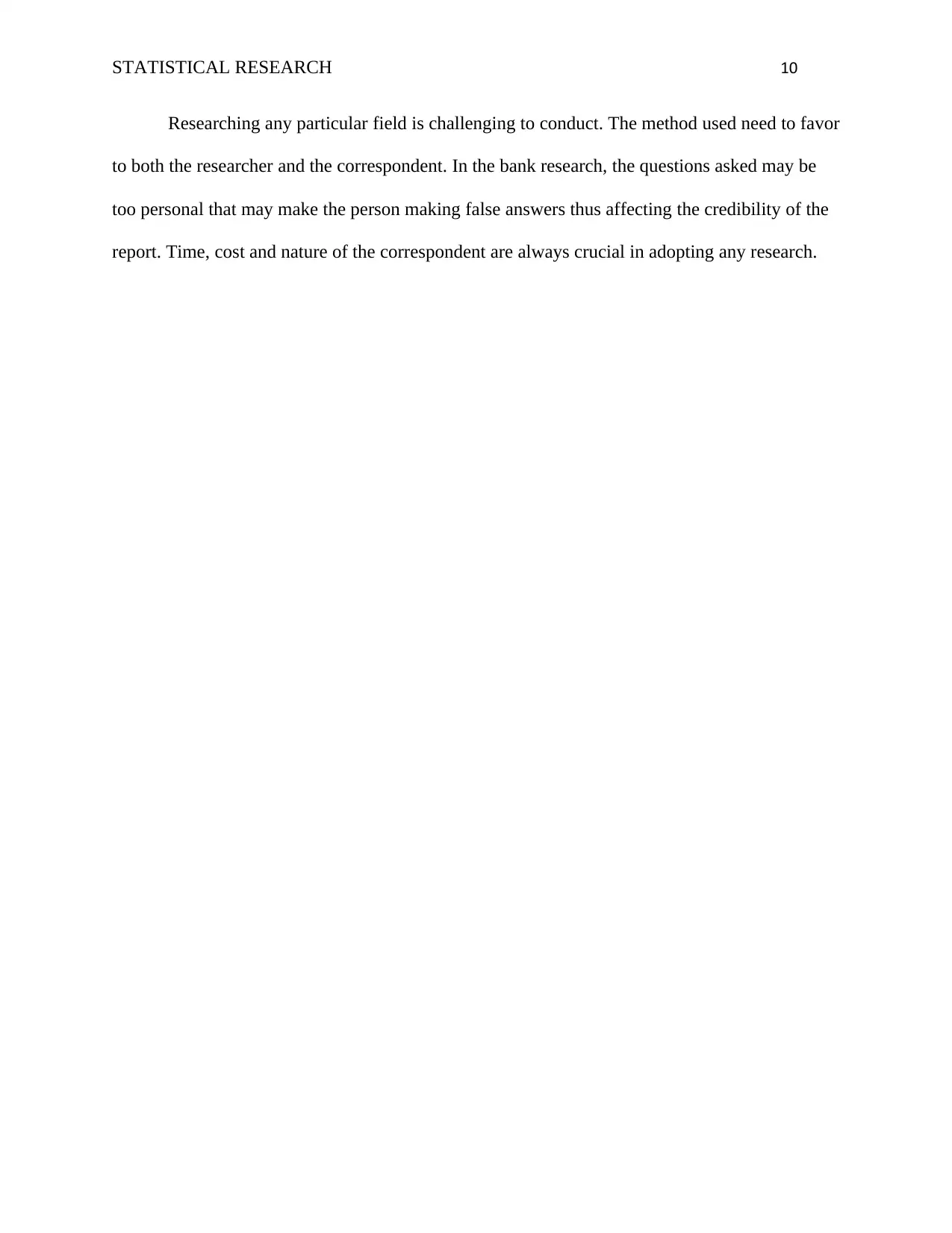
STATISTICAL RESEARCH 10
Researching any particular field is challenging to conduct. The method used need to favor
to both the researcher and the correspondent. In the bank research, the questions asked may be
too personal that may make the person making false answers thus affecting the credibility of the
report. Time, cost and nature of the correspondent are always crucial in adopting any research.
Researching any particular field is challenging to conduct. The method used need to favor
to both the researcher and the correspondent. In the bank research, the questions asked may be
too personal that may make the person making false answers thus affecting the credibility of the
report. Time, cost and nature of the correspondent are always crucial in adopting any research.
Paraphrase This Document
Need a fresh take? Get an instant paraphrase of this document with our AI Paraphraser
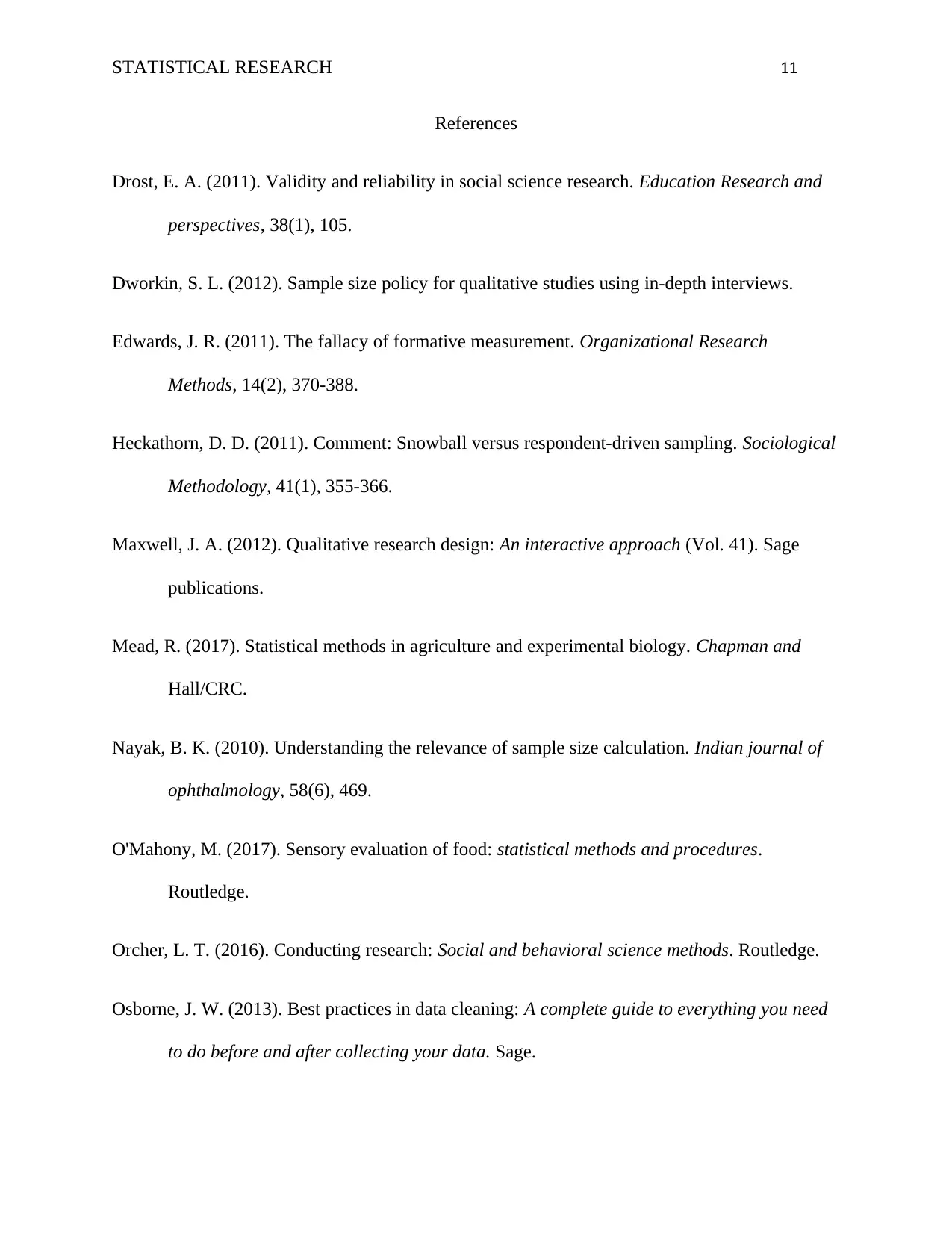
STATISTICAL RESEARCH 11
References
Drost, E. A. (2011). Validity and reliability in social science research. Education Research and
perspectives, 38(1), 105.
Dworkin, S. L. (2012). Sample size policy for qualitative studies using in-depth interviews.
Edwards, J. R. (2011). The fallacy of formative measurement. Organizational Research
Methods, 14(2), 370-388.
Heckathorn, D. D. (2011). Comment: Snowball versus respondent-driven sampling. Sociological
Methodology, 41(1), 355-366.
Maxwell, J. A. (2012). Qualitative research design: An interactive approach (Vol. 41). Sage
publications.
Mead, R. (2017). Statistical methods in agriculture and experimental biology. Chapman and
Hall/CRC.
Nayak, B. K. (2010). Understanding the relevance of sample size calculation. Indian journal of
ophthalmology, 58(6), 469.
O'Mahony, M. (2017). Sensory evaluation of food: statistical methods and procedures.
Routledge.
Orcher, L. T. (2016). Conducting research: Social and behavioral science methods. Routledge.
Osborne, J. W. (2013). Best practices in data cleaning: A complete guide to everything you need
to do before and after collecting your data. Sage.
References
Drost, E. A. (2011). Validity and reliability in social science research. Education Research and
perspectives, 38(1), 105.
Dworkin, S. L. (2012). Sample size policy for qualitative studies using in-depth interviews.
Edwards, J. R. (2011). The fallacy of formative measurement. Organizational Research
Methods, 14(2), 370-388.
Heckathorn, D. D. (2011). Comment: Snowball versus respondent-driven sampling. Sociological
Methodology, 41(1), 355-366.
Maxwell, J. A. (2012). Qualitative research design: An interactive approach (Vol. 41). Sage
publications.
Mead, R. (2017). Statistical methods in agriculture and experimental biology. Chapman and
Hall/CRC.
Nayak, B. K. (2010). Understanding the relevance of sample size calculation. Indian journal of
ophthalmology, 58(6), 469.
O'Mahony, M. (2017). Sensory evaluation of food: statistical methods and procedures.
Routledge.
Orcher, L. T. (2016). Conducting research: Social and behavioral science methods. Routledge.
Osborne, J. W. (2013). Best practices in data cleaning: A complete guide to everything you need
to do before and after collecting your data. Sage.
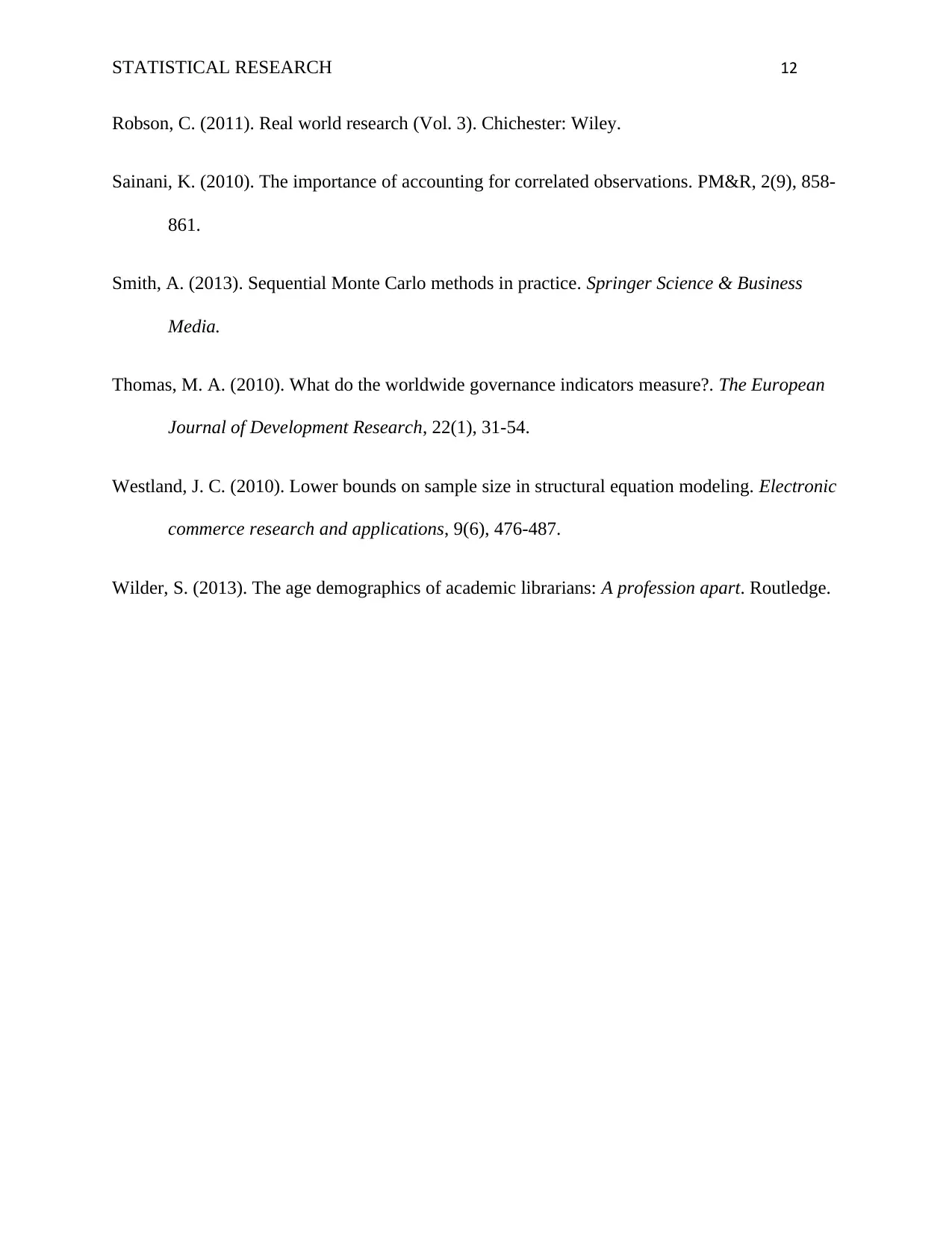
STATISTICAL RESEARCH 12
Robson, C. (2011). Real world research (Vol. 3). Chichester: Wiley.
Sainani, K. (2010). The importance of accounting for correlated observations. PM&R, 2(9), 858-
861.
Smith, A. (2013). Sequential Monte Carlo methods in practice. Springer Science & Business
Media.
Thomas, M. A. (2010). What do the worldwide governance indicators measure?. The European
Journal of Development Research, 22(1), 31-54.
Westland, J. C. (2010). Lower bounds on sample size in structural equation modeling. Electronic
commerce research and applications, 9(6), 476-487.
Wilder, S. (2013). The age demographics of academic librarians: A profession apart. Routledge.
Robson, C. (2011). Real world research (Vol. 3). Chichester: Wiley.
Sainani, K. (2010). The importance of accounting for correlated observations. PM&R, 2(9), 858-
861.
Smith, A. (2013). Sequential Monte Carlo methods in practice. Springer Science & Business
Media.
Thomas, M. A. (2010). What do the worldwide governance indicators measure?. The European
Journal of Development Research, 22(1), 31-54.
Westland, J. C. (2010). Lower bounds on sample size in structural equation modeling. Electronic
commerce research and applications, 9(6), 476-487.
Wilder, S. (2013). The age demographics of academic librarians: A profession apart. Routledge.
⊘ This is a preview!⊘
Do you want full access?
Subscribe today to unlock all pages.

Trusted by 1+ million students worldwide
1 out of 13
Related Documents
Your All-in-One AI-Powered Toolkit for Academic Success.
+13062052269
info@desklib.com
Available 24*7 on WhatsApp / Email
![[object Object]](/_next/static/media/star-bottom.7253800d.svg)
Unlock your academic potential
Copyright © 2020–2025 A2Z Services. All Rights Reserved. Developed and managed by ZUCOL.





